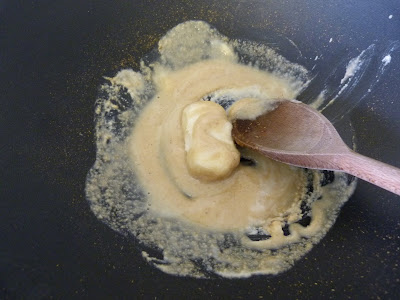
When I was growing up my Dad owned a freight forwarding business. To a young child this meant very little, and was certainly not as exciting as being able to tell other kid's your father was an astronaut or a lion tamer, but one thing I did enjoy was the exotic trips we got to go on. Due to him primarily working with Garuda Airlines this mostly meant Indonesia and, more specifically, Bali and Lombok. Although I was only young, I still remember the sights and smells - from the baskets of clove cigarettes they gave out on the aeroplane (yes, even to the children), to the hot banana fritters with cold ice cream we'd gorge ourselves on each night.
It was when I struggling to think of what to make with the two large pieces of rolled beef shin in the freezer that the idea of the Indonesian classic, rendang, sprang to mind. Rendang is originally from the Muslim area of Western Sumatra, whereas Bali is a predominately Hindu island, but the smells and the flavours of the dish bubbling away instantly bring me back to those glorious childhood memories, with the scent of lemongrass, aftersun, mozzie spray and incense thick in the air.
The tropical heat on these holidays meant constant stops for cool drinks; at home fizzy drinks were generally frowned upon, but when we were away my parents seemed to make it their sole mission to keep us slathered in sun cream and well hydrated. The swimming pool at the hotel even had a bar in the middle, where you could sit and sit and sip glass bottles of neon green Fanta and frosty cola. Amazing.
It was these memories that lead me to my my own twist on the classic rendang recipe; the addition of lemonade to provide some sweetness and a slight citrus edge. Sprite was always my Dad's favourite, but I always had a spot for 7-Up, with it's bright green bottle and distinctive red logo. As it turned out I had neither when I came to make this, settling for a can of Schweppes instead. Of course you could use a little palm sugar and fresh lemon and lime juice, but this is much more fun.
The dish originated as a way of keeping meat without refrigeration; a properly made rendang contains spices that act as natural preservatives and may be stored for up to four weeks. Although sometimes called a 'curry', rendang is a dry dish that is simmered in coconut milk and other spices until all the liquid has evaporated and the meat begins to fry in the coconut oil and fat from the meat. ('Wet rendang', where the sauce is not so heavily reduced, is known as kalio.)
Usually rendang is most often made from beef, but you also see versions made with buffalo, goat, duck, mutton or liver. Shin is a great cut to use as it's cheap and flavoursome while the slow simmering breaks this tough cut down until it's lovely and soft and sticky. The only accompaniments you will need with this very rich dish are a handful of fresh herbs, some sticky rice and a cold beer. A little lie down afterwards may also be appreciated.
Beef Shin Rendang with 7-up and Lemongrass
1 tbsp coriander seeds
1 tsp cumin seeds
1 tsp turmeric
1 tsp turmeric
5cm piece of root ginger, peeled
3 chillies (seeded if you don't like things too hot)
3 stalks of lemongrass, well trimmed
Juice half lime
3 onions
5 cloves garlic
Salt
2 bay leaves
1.5 kg beef shin or braising steak
100g coconut cream
1 tin coconut milk
1 can 7-Up (or another, full sugar, clear lemonade)
250 ml beef stock or water
Toast the coriander, cumin seeds and turmeric in a dry frying pan until lightly toasted, grind in a pestle and mortar or spice grinder until you have a fine powder. (Make sure the spices really are fine, or your rendang may taste gritty, as I have previously discovered.)
Place roughly chopped lemongrass, ginger, garlic, chillies and onions in the food processor, add salt, lime juice and ground spices and pulse into a paste.
Heat the coconut cream in a wok or shallow pan, then add the spice paste and cook out for five minutes. Add the beef, coconut milk and seven up to the pan and simmer gently until the liquid had all evaporated (this should take at least two hours, add more liquid if the pan is getting dry). Towards the end of cooking you will have to keep stirring almost continually to stop the meat catching and burning.
When all the liquid has evaporated the meat will start to fry in the remaining coconut oil. Fry for a few minutes then allow to to rest for a little while, before serving with sticky rice and a scattering of fresh coriander.
This should keep well in the fridge for at least a week and, like most slow cooked dishes, often tastes better after a spending a night or two in the fridge.





